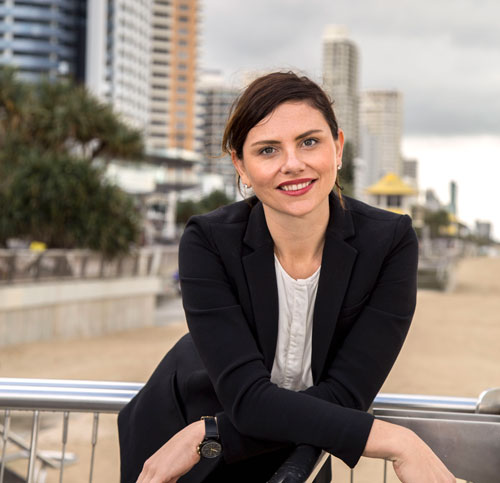“Shannon Willoughby, 32, is the immediate past, long-term president of Young Professionals Gold Coast, chief executive of Study Gold Coast and a former senior journalist at the Gold Coast Bulletin. She is infinitely passionate about the Gold Coast and has been a leader in drawing attention to the city’s issues and potential.
As a columnist and chief reporter at the Bulletin, Shannon was never backward in coming forward with opinion, often controversial, but always directed at constructive outcomes. Also during her time at the Bulletin, she worked as a business writer throughout the global financial crisis. She reported on a flood of corporate events, many tragic, covering the collapse of dozens of Gold Coast enterprises – most operating in the construction and property industries. These times and events drove home to Shannon the need to create and promote a more diverse Gold Coast, not reliant so much on the cyclical property and tourism sectors.
While recognising the ongoing and vital importance of these sectors she has been prepared to do all she can to fulfill her vision of a city full of new opportunities and vitality driven by smart young thinkers. She is a champion of the city’s generation Y go-getters who want change for the betterment of the Gold Coast and themselves – now! As the chief executive of Study Gold Coast, the first joint promotional effort of the city’s major tertiary industry stakeholders and the Gold Coast City Council.
Shannon is now playing a key role in making national and international markets aware of the City’s education and training assets.
Like other YPGC movers and shakers she wants the Coast to be known for its diverse, innovative industries, for its outstanding education and health sectors, and for new cultural assets and creativity, to name just some platforms for progress. She wants to see new, more universal strategies to promote the Gold Coast’s diversity – they want to see a complete picture of the Gold Coast’s assets effectively projected to the world at the 2018 Commonwealth Games – the best opportunity the City has had to tell its full story to vast international audiences.
Here Shannon comments on whole of city issues, the roles of YPGC and highlights the importance of the Coast’s burgeoning education sector:
What has been the key focus of YPGC under your presidency?
One of the key ongoing roles of YPGC is to dismantle the negative perceptions of the Gold Coast and we have been focused on this since foundation and throughout the global financial crisis to today. We have been able to connect a lot of people who are all sick of the Gold Coast’s image being trashed. The reality is that there is and always has been a big, vibrant and very active and positive corporate culture on the Gold Coast.
Many members, while young, saw the impacts of the GFC on businesses and families – we learned a lot from the experience. A lot of young professionals are very wise for their age. The city was not well equipped to handle a GFC and I don’t think it is in a much better position now to handle another downturn because it is still too reliant on the tourism and property industries.
What have been the main achievements of YPGC to date?
Over the years we have built the YPGC brand to the stage where we now have a membership database of 1500 people – young, fresh, energised 20 to 40-year-olds who are passionate about the City and want to see positive change. We have attracted prominent speakers to YPGC events over the years including Jeff Kennett, Harry Triguboff, David Kosh, Bernard Salt, Soheil Abebian, Travis Auld and Lucy Turnball.
We provide a new audience for these speakers and everyone feels energised as a result – we’ve done pretty well for ourselves in terms of brand building and the organisation is well received. When we get together we create opportunities – it’s a network, an opportunity to talk with peers and to meet with people from other organisations – communication that can produce jobs and career changing opportunities. Our members will be the next city and state leaders.
Its up to people like us to bring about positive change – as like-minded individuals we are determined to push out some different messages.
How big is the education-training sector on the Gold Coast and what is its potential?
The importance of the education sector on the Gold Coast is huge. The economic contribution of foreign students on the Gold Coast is already one fourth of the contribution of tourism; 17,000 students (from overseas) commenced studies on the Coast last year; we have 47,000 students, post year 12, studying here (domestic and international) and then you have 80,000 students at school from prep to year 12. Onefifth of the Gold Coast’s population is students.
We have three universities and in the past five years these universities and TAFE have spent $500 million on tangible infrastructure and that does not include what has been done at all the schools and various private colleges.
The Gold Coast is a vibrant location for students and the Federal Government wants to double the number of them in Australia. The Gold Coast is an excellent position to capitalise on this situation.
What is Study Gold Coast and what are your goals as chief executive?
Study Gold Coast (SGC) is the peak body representing education and training on the Coast. Local government provides half of the funding with the balance from “the big four” – Griffith University, Bond University, South Cross University and TAFE. It is the first time these institutions have worked collaboratively in this way. Senior representatives from all of them and the Gold Coast City Council sit on the SGC board, chaired by former Queensland Premier, Rob Borbidge.
Our role is marketing and advocacy – we market the Gold Coast as an education and training destination. Our work includes collection of data on what the city’s education sector is worth; we engage with students and organise events and market to national and international audiences. Students are our biggest advocates – they deliver messages to families and friends about studying here – they love it and this messaging also feeds tourism. Statistics show that parents of Gold Coast students from abroad will visit their child twice during a three – year study term. They stay for three weeks and 20 per cent will do so in an international hotel.
Education is a huge contributor to the tourism sector and ultimately the property industry as well. Our strategic offshore marketing is focused on China, Japan, the Middle East and South America. Very specific marketing initiatives will be undertaken in these countries during the next couple of years. For example, tourism has done an amazing job in China but no one there knows the Gold Coast as an education destination – we are competing with the likes of Melbourne and Sydney.
What needs to be done to create more jobs on the Coast?
For kids growing up through high school there is the perception that the Coast doesn’t offer a lot in terms of careers – that there is “nothing to do”.
Job creation is a huge challenge for the city – there is a lot of part time work available in hospitality and retail, but where are our smart jobs? Where can smart graduates career climb and end up earning $250K a year? These opportunities are very, very limited, and this turns a lot of young people away.
This is why education and training are so important – we need to promote the City as an education destination – the bigger the pool of talent we have on the Coast, the more opportunity there will be attract industry, to create jobs and careers. We have a bucket load of intelligent, highly qualified talent here. Where do the bright young people go – where will our kids go? We are limited by the options. I’m not interested in hearing about more jobs, I’m interested in hearing about more careers, about new industries being established on the Coast.
In this regard I think the cultural community is also very important because it will attract a new generation of creative people with the capability of making change.
So where is the greatest potential for the Gold Coast?
The greatest potential lies with the education, cultural and health sectors and the challenge is how we push these industries, while at the same time continuing to promote to the tourism and property markets – the importance of these core industries remains but its like putting all your eggs in one basket. For example tourism and education work closely together – it’s about spreading more love – we need to think about what we want the city to look like, defining and promoting it with new strategies.
For example, are we “a sustainable tourism city with great cultural elements, and an outstanding education sector”? In very simplistic terms, how do we map out what the City really is and what it will be in the future? A lot of work is being done on this with the input of demographer Bernard Salt taking in culture, health care and education/training.
These three industries need support and need to out into the foreground. When we look at how we sell our universities we have the highly progressive Griffith beside the $1.7 billion University Hospital – the biggest in the southern hemisphere; Bond as Australia’s only private university with its beautiful sandstone architecture and Soheil Abedian Architecture building; then down south we have a campus on the beach with Southern Cross and one of the most modern TAFE centres in Australia.
What is being done to push these sectors now?
It is happening – it is about educating everyone about the need to support these industries because there will be wide reaching long term benefits. Study Gold Coast is pushing the education sector – our mantra is “Australia’s favourite classroom”. We also have the Gold Coast’s Cultural Committee. The Mayor is keen to substantially enhance the city’s cultural presence with the new (proposed) arts centre and another example is the Council investment in the Bleach Festival. In my mind health, education, and culture (along with innovation) can be used to build a new platform at grass roots and city presence levels and clearly there are some outstanding assets for us to promote.
What are some key ongoing city issues?
Infrastructure and public transport remain as key issues, especially in regard to the extension of the light rail; but communication of the complete picture of the Gold Coast really is to its various key markets in Australia and abroad is vital – we must tell the real story. And there needs to be more engagement with the younger generation, regarding the city of the future – now is the time for fresh blood.
They can contribute much to future planning beyond the terms of current governments. There is a really big opportunity with the Commonwealth Games to provide some meaningful legacy for the city; not just a new stadium here and a new basketball court there. It is the new industries we want. There is no more important time than between now and the Commonwealth Games for the City to get its act together in relation to the messages it needs to deliver to the world at this time.
Author: Sean Braybrook






